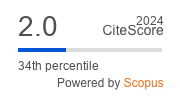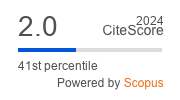| 2/2025 - 4 |
Chaotic Image Encryption using Two Level ScramblingSUBHASHINI, K. |
| Extra paper information in |
| Click to see author's profile in |
| Not available online | Downloads: 0 | Views: 15 |
Author keywords
chaos, encryption, image, information theory, multimedia systems
References keywords
optical(19), communication(11), space(8), free(8), fiber(8), filter(7), communications(7), prakash(6), networks(6), modulation(6)
No common words between the references section and the paper title.
About this article
Date of Publication: 2025-06-30
Volume 25, Issue 2, Year 2025, On page(s): 27 - 36
ISSN: 1582-7445, e-ISSN: 1844-7600
Digital Object Identifier: 10.4316/AECE.2025.02004
Abstract
With the introduction of the 5G technology, transmission of multimedia data is very high which demands data security. Image encryption techniques secure the transmission of image data from the intruder. We proposed a one-dimensional chaotic map whose chaotic behaviour over a wide range of control parameters is verified experimentally. Image encryption algorithm using two level permutations and one level diffusion is proposed in this paper. First level permutation is done on block level using one chaotic sequence. In the second level, entire image is permuted. Row and column diffusion is done using two chaotic sequences. From the experimental results and analysis, it is evident that the proposed image encryption algorithm resists differential and statistical attacks. |
| References | | | Cited By «-- Click to see who has cited this paper |
| [1] X. Liu, F. Effenberger, "Emerging optical access network technologies for 5G wireless," in Journal of Optical Communications and Networking, vol. 8, no. 12, pp. B70-B79, Nov. 2016. [CrossRef] [SCOPUS Times Cited 152] [2] J.-i. Kani, J. Terada, K. I. Suzuki, A. Otaka, "Solutions for future mobile fronthaul and access-network convergence," in Journal of Lightwave Technology, vol. 35, no. 3, pp. 527-534, Feb. 2017. [CrossRef] [SCOPUS Times Cited 106] [3] M. A. Khalighi, M. Uysal, "Survey on free space optical communication: A communication theory perspective," in IEEE Communications Surveys & Tutorials, vol. 16, no. 4, pp. 2231-2258, 2014. [CrossRef] [SCOPUS Times Cited 2094] [4] M. Alzenad, M. Z. Shakir, H. Yanikomeroglu, M. S. Alouini, "FSO-based vertical backhaul/fronthaul framework for 5G+ wireless networks," in IEEE Communications Magazine, vol. 56, no. 1, pp. 218-224, Jan. 2018. [CrossRef] [SCOPUS Times Cited 435] [5] L. Vallejo, B. Ortega, J. Bohata, S. Zvanovec, V. Almenar, "Experimental photonic 40-90 GHz millimetre-wave signal generation and 10 Gb/s 32-QAM signal transmission over hybrid fiber/FSO 5G networks," 21st International Conference on Transparent Optical Networks (ICTON), Angers, France, 2019, pp. 1-4. [CrossRef] [SCOPUS Times Cited 4] [6] P. Prakash, P. Kasthuri, M. Ganeshmadhan, S. Arul Prakash, "Simulations of mode division multiplexed free space optics with photonics traversal filter using multi-mode fiber," Informacije MIDEM - Journal of Microelectronics, Electronic Components and Materials, vol. 51, no. 4, pp. 207-213, 2021. [CrossRef] [SCOPUS Times Cited 3] [7] P. Kasthuri, P. Prakash, "Performance analysis of delay line filter using X-coupler and delay line IIR filter," Fourth International Conference on Signal Processing, Communication and Networking (ICSCN), Chennai, India, 2017, pp. 1-4. [CrossRef] [SCOPUS Times Cited 5] [8] A. Anuranjana, S. Kaur, R. Goyal, S. Chaudhary, "1000 Gbps MDM-WDM FSO link employing DP-QPSK modulation scheme under the effect of fog," in Optik, vol. 257, pp. 1-10, 2022, 168809, ISSN 0030-4026. [CrossRef] [SCOPUS Times Cited 42] [9] H. Singh, N. Mittal, "Link budget analysis of free space optical communication link for atmospheric conditions of India," Materials Today: Proceedings, vol. 48, 2022, pp. 1064-1069. [CrossRef] [SCOPUS Times Cited 5] [10] H.-H. Lu, et al., "An integrated fiber-FSO-5G NR Sub-THz link with 86.112 Gbps high aggregate data rates," in Journal of Lightwave Technology, vol. 40, no. 24, pp. 7790-7798, Dec. 2022. [CrossRef] [SCOPUS Times Cited 18] [11] F. El-Nahal, T. Xu, D. AlQahtani, M. Leeson, "A bidirectional WDM-PON free space optical (FSO) system for fronthaul 5G C-RAN networks," IEEE Photonics Journal, vol. 15, no. 1, pp. 1-10, Feb. 2023. [CrossRef] [SCOPUS Times Cited 21] [12] X. Ao, et al., "Real-time experimental demonstration of hybrid FSO/wireless transmission based on coherent detection and delta-sigma modulation," in IEEE Photonics Journal, vol. 14, no. 6, pp. 1-8, Dec. 2022, Art no. 7359908. [CrossRef] [SCOPUS Times Cited 6] [13] Chung-Yi Li, et al., "A flexible bidirectional fiber-FSO-5G wireless convergent system," in Journal of Lightwave Technology, vol. 39, no. 5, pp. 1296-1305, Mar. 2021. [CrossRef] [SCOPUS Times Cited 48] [14] Y.-S. Lin, W.-C. Fan, C.-J. Lin, C.-Y. Li, H.-H. Lu, "Bi-directional 5G NR fiber-wireless systems with single-carrier optical modulation and phase modulation scheme," Optical Fiber Communication Conference (OFC), San Diego, CA, USA, 2023, pp. Tu3J.2. [CrossRef] [15] H.-H. Huang, Y.-E. Peng, Y.-S. Lin, W.-C. Fan, Y.-X. Chen, H.-H. Lu, "5G NR fiber-FSO-wireless systems with dual-polarization and single-carrier optical modulation schemes (invited)," in Optics Communications, vol. 530, pp. 129197, Mar. 2023. [CrossRef] [SCOPUS Times Cited 7] [16] C. K. Madsen, J. H. Zhao, "Digital filters concepts for optical filters," in Optical Filter Design and Analysis, pp. 95-164, Hoboken, NJ, USA: Wiley, Jun. 1999. [CrossRef] [17] T. Duthel, M. Otto, C. G. Schaffer, "Simple tunable all-fiber delay line filter for dispersion compensation," in IEEE Photonics Technology Letters, vol. 16, no. 10, pp. 2287-2289, Oct. 2004. [CrossRef] [SCOPUS Times Cited 9] [18] L. M. Lunardi, et al., "Tunable dispersion compensation at 40-Gb/s using a multicavity etalon all-pass filter with NRZ, RZ, and CS-RZ modulation," in Journal of Lightwave Technology, vol. 20, no. 12, pp. 2136-2144, Dec. 2002. [CrossRef] [SCOPUS Times Cited 75] [19] S. Sharma, A. S. Madhukumar, R. Swaminathan, "Switching-based cooperative decode-and-forward relaying for hybrid FSO/RF networks," in Journal of Optical Communications and Networking, vol. 11, no. 6, pp. 267, May 2019. [CrossRef] [SCOPUS Times Cited 83] [20] M. S. Sowmyaa Vathsan, P. Kasthuri, P. Prakash, A. Sasithradevi, "Analysis of atmospheric attenuation of a FSO-WDM system for long-range communication," in Journal of Optical Communications, vol. 45, no. s1, pp. s2059-s2066, 2024. [CrossRef] [SCOPUS Times Cited 2] [21] H. Kaushal, V. K. Jain, S. Kar, "Free-space optical channel models," in Free Space Optical Communication, pp. 41-89, Springer India, 2017. [CrossRef] [22] V. Gayathri, P. Prakash, P. Kasthuri, P. Pavithra, "Investigation of WDM-MIMO channel with DLF in free space optical communication," 2022 International Conference on Communication, Computing and Internet of Things (IC3IoT), Chennai, India, 2022, pp. 1-4. [CrossRef] [SCOPUS Times Cited 2] [23] F. El-Nahal, T. Xu, D. AlQahtani, M. Leeson, "A bidirectional wavelength division multiplexed (WDM) free space optical communication (FSO) system for deployment in data center networks (DCNs)," Sensors, vol. 22, no. 24, pp. 9703, Dec. 2022. [CrossRef] [SCOPUS Times Cited 23] [24] R. R. Beland, "Propagation through atmospheric optical turbulence," in The Infrared & Electro-Optical Systems Handbook, Vol. 2: Atmospheric Propagation of Radiation, pp. 157-232, Bellingham, WA, USA: SPIE Press, 1993. [CrossRef] [25] S. Deepshikha, R. Swaminathan, "Comprehensive performance analysis of hovering UAV-based FSO communication system," in IEEE Photonics Journal, vol. 14, no. 5, pp. 1-13, Oct. 2022, Art no. 7352013. [CrossRef] [SCOPUS Times Cited 53] [26] G. Aarthy, P. Prakash, M. G. Madhan, "Design and analysis of 4 port coupler based Delay Line filter for dispersion slope compensation," in IEEE International Conference on Advanced Communications, Control and Computing Technologies, Ramanathapuram, India, 2014, pp. 120-123. [CrossRef] [SCOPUS Times Cited 1] Web of Science® Citations for all references: 0 SCOPUS® Citations for all references: 3,194 TCR Web of Science® Average Citations per reference: 0 SCOPUS® Average Citations per reference: 118 ACR TCR = Total Citations for References / ACR = Average Citations per Reference We introduced in 2010 - for the first time in scientific publishing, the term "References Weight", as a quantitative indication of the quality ... Read more Citations for references updated on 2025-06-30 17:18 in 173 seconds. Note1: Web of Science® is a registered trademark of Clarivate Analytics. Note2: SCOPUS® is a registered trademark of Elsevier B.V. Disclaimer: All queries to the respective databases were made by using the DOI record of every reference (where available). Due to technical problems beyond our control, the information is not always accurate. Please use the CrossRef link to visit the respective publisher site. |
Faculty of Electrical Engineering and Computer Science
Stefan cel Mare University of Suceava, Romania
All rights reserved: Advances in Electrical and Computer Engineering is a registered trademark of the Stefan cel Mare University of Suceava. No part of this publication may be reproduced, stored in a retrieval system, photocopied, recorded or archived, without the written permission from the Editor. When authors submit their papers for publication, they agree that the copyright for their article be transferred to the Faculty of Electrical Engineering and Computer Science, Stefan cel Mare University of Suceava, Romania, if and only if the articles are accepted for publication. The copyright covers the exclusive rights to reproduce and distribute the article, including reprints and translations.
Permission for other use: The copyright owner's consent does not extend to copying for general distribution, for promotion, for creating new works, or for resale. Specific written permission must be obtained from the Editor for such copying. Direct linking to files hosted on this website is strictly prohibited.
Disclaimer: Whilst every effort is made by the publishers and editorial board to see that no inaccurate or misleading data, opinions or statements appear in this journal, they wish to make it clear that all information and opinions formulated in the articles, as well as linguistic accuracy, are the sole responsibility of the author.



